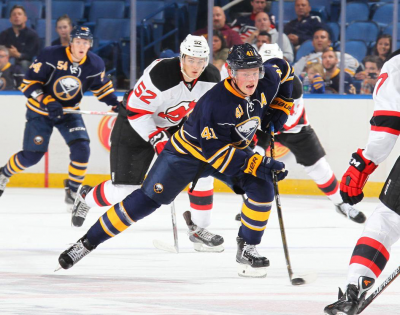Anthony Donskov
Stride Length vs Stride Rate
- Font size: Larger Smaller
- Hits: 4665
- Subscribe to this entry
- Bookmark
The hockey stride has been described by bio-mechanists as biphasic in nature consisting of alternating periods of single leg and double leg support. The single support phase corresponds to a period of glide, while the double support phase corresponds to the onset and preparation of propulsion (Marino, 1977). Both stride rate and stride length have been investigated as a means of measuring/separating the skating velocities of high caliber and low caliber skaters. The purpose of this short blog is to investigate the research in order to answer the question: which is more important, stride length, or stride rate?
Before digging deeper, I wanted to give my personal thoughts on what contributes to each variable. This is nothing more than my hypothesis based on personal experience.

Stride Length: Strength + Mobility + Technique (Early focus for young players)
Stride Rate: CNS + Muscle architecture + lever system + RFD (As technique becomes reinforced, a shift in focus for advanced players)
Research:
(Marino et al., 1977) Kinematics of skating at Different Velocities
Purpose: To quantify and compare the temporal aspects of the skating stride performed at three different velocities.
- As skating velocity increased, mean stride rate also increased
- As skating speed changed there was a statistically significant accompanying change in stride rate, single support time and double support time
- When velocity was high, stride rate was high
- This would indicate that fast speed is more dependent on the number of times that force of propulsion is applied, than the force of each propulsion
- Both glide and propulsive phases decreased markedly as velocity increased
- Stride rate seems to be the most important element
(Upjohn et al., 2008) Three-Dimensional Kinematics of the Lower Limb during forward ice hockey skating
Purpose: Describe lower limb kinematics in three dimensions during the fwd. skating stride and contrast b/w high caliber vs low caliber players
- High caliber skaters achieved faster skating velocities even though stride rates were similar (59 vs 55 strides/min). High caliber skaters demonstrated BOTH significantly > stride length and stride width than low-caliber skaters
- Largest ROM were observed in the sagittal plane
- High caliber skaters generated > hip flexion at weight acceptance and > knee extension and plantarflexion at propulsion
- High caliber skaters were more flexed at the hip, knee and more dorsiflexed at the foot-ankle throughout support
- Increased knee flexion = increase in elastic energy of the quads in concentric push off
- A greater rate of hip flexion at weight acceptance is indicative of a > degree of eccentric contraction of the anterior thigh muscles before concentric contraction during propulsion
- Stride length seems to be the biggest difference b/w high vs low caliber skaters
(Shell et al., 2017) Skating Start Propulsion: 3-Dimensional kinematic analysis of elite male and female hockey players
Purpose: Evaluate the body movement kinematics of ice hockey skating b/w elite male and female ice hockey participant
- Groups had similar stride lengths but different stride widths, males had significantly wider steps
- Hip flexion/extension was significantly greater in males than females during the latter stance phase
- Females were less abducted than male skaters by 10 degrees
- Male’s greater average stride rate and longer step lengths were not significantly different from females, however they combined to result in higher skating velocity
- Main difference may be related to lower body strength
- Strength (the ability to create friction on the ice using large propulsive angles) may be the difference b/w skating velocity
(Budarick et al., 2018) Ice Hockey Skating Sprints: run to glide mechanics of high caliber male and female athletes
Purpose: Compare body center of mass and lower body kinematic profiles from static start to maximal speed of high caliber male and female ice hockey players
- Over the first 7 steps, males reached higher speeds than females
- Hip: The combination of hip adduction and abduction show that females were more adducted through all stance phases
- Knee: Males were more flexed at ice contact and during stance than females
- Males had greater knee flexion angles and hip abduction angles than females
- The run to glide transition can be identified at approximately the third stride (5thstep)
- Both male and females were still accelerating at the end of the 5s (34 m)
- No differences in step width were found
- As skaters reach their max speed, step widths become smaller b/c there is less need to create friction on the ice and wider steps are less necessary to promote balance or stability
- Both strength and stride length seem to be the biggest variables separating these populations
As one would imagine, there is no black and white answer as to which is more important, stride length, stride rate, stride width, or relative strength. Coupled with the fact that hockey biomechanics research is not nearly as prevalent in ice hockey as field-based sports. In situations such as these perhaps a portfolio style approach is warranted (diversify the program with elements of each: strength, mobility, RFD etc.).
We focus much more on basic, foundational strength work with our youth athletes. However, in recent years, we have focused more on the velocity side with our mature, advanced training age demographic. Although the research doesn’t clearly steer us in one direction, our goal is to use the strength that has been acquired throughout the years faster, more efficiently in order to improve stride rate and turnover on the ice.
